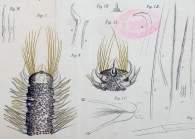WoRMS taxon details
Poecilochaetus fulgoris Claparède in Ehlers, 1875
130710 (urn:lsid:marinespecies.org:taxname:130710)
accepted
Species
marine, brackish, fresh, terrestrial
recent only
Ehlers, E. (1875). Beiträge zur Kenntniss der Verticalverbreitung der Borstenwürmer im Meere. <em>Zeitschrift für wissenschaftliche Zoologie.</em> 25: 1-102, plates I-IV., available online at https://www.biodiversitylibrary.org/page/45143254
page(s): 9-13, plate I fig. 1 [details]
page(s): 9-13, plate I fig. 1 [details]
Holotype , geounit Atlantic Ocean
, Note Allen (1904:80) comments on P. fulgoris "In...
Holotype, geounit Atlantic Ocean [details]
From editor or global species database
Type locality Allen (1904:80) comments on P. fulgoris "In the same paper Ehlers refers to two fragments of the worm described by Claparede, which he found amongst the material dredged by the " Porcupine." According to the table given (loc. cit., p. 25), these were dredged on July 21st, 1869, at 48° 51' N., 11° T W. (11° 9' W.) in 725 fathoms, on a bottom of muddy sand. [details]
Etymology 'fulgoris' after the expedition vessel "Lightning"
Etymology 'fulgoris' after the expedition vessel "Lightning" [details]
Read, G.; Fauchald, K. (Ed.) (2024). World Polychaeta Database. Poecilochaetus fulgoris Claparède in Ehlers, 1875. Accessed through: World Register of Marine Species at: https://www.marinespecies.org/aphia.php?p=taxdetails&id=130710 on 2024-04-19
Date
action
by
![]() The webpage text is licensed under a Creative Commons Attribution 4.0 License
The webpage text is licensed under a Creative Commons Attribution 4.0 License
original description
Ehlers, E. (1875). Beiträge zur Kenntniss der Verticalverbreitung der Borstenwürmer im Meere. <em>Zeitschrift für wissenschaftliche Zoologie.</em> 25: 1-102, plates I-IV., available online at https://www.biodiversitylibrary.org/page/45143254
page(s): 9-13, plate I fig. 1 [details]
context source (Deepsea) Budaeva N.E., Jirkov I.A., Savilova T.A., Paterson G.L.J. (2014). Deep-sea fauna of European seas: An annotated species check-list of benthic invertebrates living deeper than 2000 m in the seas bordering Europe. Polychaeta. <i>Invertebrate Zoology</i>. Vol.11. No.1: 217–230 [in English]. [details] Available for editors [request]
[request]
basis of record Bellan, G. (2001). Polychaeta, <i>in</i>: Costello, M.J. <i>et al.</i> (Ed.) (2001). European register of marine species: a check-list of the marine species in Europe and a bibliography of guides to their identification. <em>Collection Patrimoines Naturels.</em> 50: 214-231. (look up in IMIS) [details]
additional source Allen, E. J. (1904). The anatomy of Poecilochaetus, Claparède. <em>Quarterly Journal of Microscopical Science, London.</em> 48: 79-151., available online at http://jcs.biologists.org/content/s2-48/189.toc [details]
additional source Hartman, O. (1965). Deep-water benthic polychaetous annelids off New England to Bermuda and other North Atlantic areas. <em>Occasional Papers of the Allan Hancock Foundation.</em> 28: 1-384., available online at http://digitallibrary.usc.edu/cdm/ref/collection/p15799coll82/id/20299
page(s): 161-162, plate 33 figs. a-e [details]
additional source Fauchald, K. (1977). The polychaete worms, definitions and keys to the orders, families and genera. <em>Natural History Museum of Los Angeles County: Los Angeles, CA (USA), Science Series.</em> 28:1-188., available online at http://www.vliz.be/imisdocs/publications/123110.pdf [details]
page(s): 9-13, plate I fig. 1 [details]
context source (Deepsea) Budaeva N.E., Jirkov I.A., Savilova T.A., Paterson G.L.J. (2014). Deep-sea fauna of European seas: An annotated species check-list of benthic invertebrates living deeper than 2000 m in the seas bordering Europe. Polychaeta. <i>Invertebrate Zoology</i>. Vol.11. No.1: 217–230 [in English]. [details] Available for editors
basis of record Bellan, G. (2001). Polychaeta, <i>in</i>: Costello, M.J. <i>et al.</i> (Ed.) (2001). European register of marine species: a check-list of the marine species in Europe and a bibliography of guides to their identification. <em>Collection Patrimoines Naturels.</em> 50: 214-231. (look up in IMIS) [details]
additional source Allen, E. J. (1904). The anatomy of Poecilochaetus, Claparède. <em>Quarterly Journal of Microscopical Science, London.</em> 48: 79-151., available online at http://jcs.biologists.org/content/s2-48/189.toc [details]
additional source Hartman, O. (1965). Deep-water benthic polychaetous annelids off New England to Bermuda and other North Atlantic areas. <em>Occasional Papers of the Allan Hancock Foundation.</em> 28: 1-384., available online at http://digitallibrary.usc.edu/cdm/ref/collection/p15799coll82/id/20299
page(s): 161-162, plate 33 figs. a-e [details]
additional source Fauchald, K. (1977). The polychaete worms, definitions and keys to the orders, families and genera. <em>Natural History Museum of Los Angeles County: Los Angeles, CA (USA), Science Series.</em> 28:1-188., available online at http://www.vliz.be/imisdocs/publications/123110.pdf [details]
 Present
Present  Present in aphia/obis/gbif/idigbio
Present in aphia/obis/gbif/idigbio  Inaccurate
Inaccurate  Introduced: alien
Introduced: alien  Containing type locality
Containing type locality
Holotype, geounit Atlantic Ocean [details]
From editor or global species database
Etymology 'fulgoris' after the expedition vessel "Lightning" [details]Type locality Allen (1904:80) comments on P. fulgoris "In the same paper Ehlers refers to two fragments of the worm described by Claparede, which he found amongst the material dredged by the " Porcupine." According to the table given (loc. cit., p. 25), these were dredged on July 21st, 1869, at 48° 51' N., 11° T W. (11° 9' W.) in 725 fathoms, on a bottom of muddy sand. [details]
